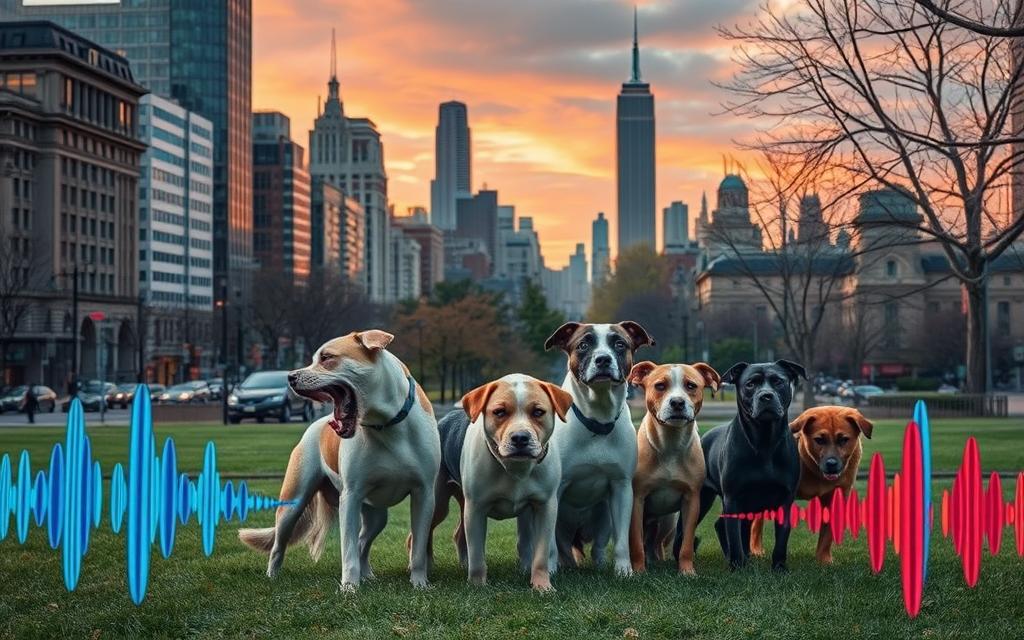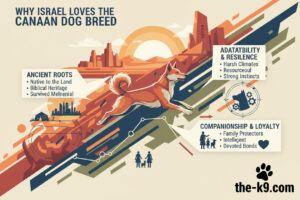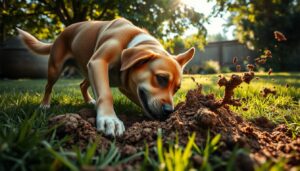
City Noise on Dogs’ Mental Health. The constant noise of traffic, construction, and sirens is a big part of city life. It can deeply affect our dogs’ mental health. Studies show that dogs in cities are much more anxious and fearful than those in the countryside.
This is a serious issue that we need to tackle quickly. We must find ways to protect our dogs from the harmful effects of city noise.
Key Takeaways: City Noise on Dogs’ Mental Health
- City noise can lead to increased anxiety, fearfulness, and behavioral problems in dogs.
- Factors like traffic noise, lack of green spaces, and social isolation contribute to the negative impact of urban living on dog mental health.
- Dogs living in the most urbanized settings exhibit up to 70% higher levels of fear towards other dogs and 45% higher fear of strangers compared to rural dogs.
- Certain breeds, neutered females, and dogs with limited socialization are more prone to noise-related behavioral issues.
- Proper training, socialization, and owner involvement can help mitigate the adverse effects of city noise on dogs’ mental well-being.
- Introduction to Noise Pollution
- Effects of Noise Pollution on Wildlife
- City Noise on Dogs' Mental Health
- Prevalence of Noise-Related Behavioral Problems in Dogs
- Environmental Factors Associated with Non-Social Fear
- Breed Differences in Noise Sensitivity
- Age and Non-Social Fear
- Impact of Inadequate Socialization
- Role of Owner Experience and Training
- Urbanization and Dog Mental Health
- Conclusion: City Noise on Dogs' Mental Health
- FAQ
Introduction to Noise Pollution
Definition and Types of Noise Pollution
Noise pollution is when there’s too much or unpleasant sound around. It comes from many sources of noise pollution like traffic, construction, and even fun activities. Urban noise is especially bad because of all these sounds together.
It can really hurt people and animals. It messes with sleep, causes stress, and can lead to health problems.
There are different kinds of types of noise pollution that affect us. Some common ones are:
- Transportation noise (e.g., cars, trucks, planes, trains)
- Industrial noise (e.g., manufacturing equipment, power plants)
- Construction noise (e.g., heavy machinery, demolition)
- Recreational noise (e.g., music, events, sports)
- Environmental noise (e.g., wildlife, weather)
These sources of noise pollution really affect our urban and environmental spaces. They harm both people and animals. Knowing about noise pollution and its types helps us tackle this big problem.
| Type of Noise Pollution | Typical Sources | Potential Impacts |
|---|---|---|
| Transportation Noise | Cars, trucks, planes, trains | Disruption of sleep, stress, hearing damage |
| Industrial Noise | Manufacturing equipment, power plants | Hearing loss, interference with communication |
| Construction Noise | Heavy machinery, demolition | Disturbance of daily activities, stress |
| Recreational Noise | Music, events, sports | Annoyance, disruption of sleep, hearing damage |
| Environmental Noise | Wildlife, weather | Disruption of natural habitats, stress on animals |
Effects of Noise Pollution on Wildlife
Many studies show how noise pollution affects wildlife. It can mess up important behaviors and health in animals living in water and on land. It can mess with how they talk, find food, and even stress them out.
For fish and sea mammals, underwater noise is a big problem. It makes it hard for them to move, talk, and find food. This can change how they behave and might hurt their health. Birds and small mammals on land also get stressed and change their behavior when they hear too much noise.
| Impact of Noise Pollution on Wildlife | Examples |
|---|---|
| Disruption of Communication | Underwater noise can interfere with the ability of fish and marine mammals to hear each other, affecting social interactions and mating. |
| Altered Foraging Behavior | Noise pollution can cause animals to change their foraging patterns, leading to disruptions in their food supply and energy balance. |
| Physiological Stress | Chronic exposure to noise can induce heightened stress levels, suppressed immune systems, and reproductive issues in wildlife. |
| Hearing Damage | Sudden loud sounds, such as those from construction activities, can physically harm the auditory systems of animals, leading to long-term impairment. |
The harm noise pollution does to wildlife shows we need stricter rules and action to protect nature. By tackling this problem, we can help keep animals healthy and ecosystems balanced.
“Noise pollution can have a profound and far-reaching impact on wildlife, disrupting their essential behaviors and physiological processes. It is a critical environmental issue that requires immediate attention and action.”
City Noise on Dogs’ Mental Health
Dogs in cities face the same noise pollution as humans. This can make them more fearful and anxious. They might become scared of strangers and other animals. This fear can cause problems like barking too much, hiding, and even being aggressive.
A study at the University of California, Davis, looked at 386 dog owners. They found that owners often don’t see how scared their dogs are of everyday sounds. Most people laughed when they saw their dogs acting scared, instead of worrying about them.
Dogs show anxiety in many ways. They might cringe, tremble, or hide. They could also pant, lick their lips, or turn their ears back. High-pitched, intermittent sounds like a smoke detector alarm can scare them more than loud, steady noises.
| Noise Type | Impact on Dogs |
|---|---|
| High-frequency, intermittent noises | More likely to cause anxiety |
| Low-frequency, continuous noise | Less likely to cause anxiety |
Dogs can find loud or high-pitched sounds very painful. It’s important to find and reduce sources of stress for them. This can help keep them calm and happy.
Teaching dog owners about anxiety is key. Many dogs, up to 50%, are sensitive to noise. This stress can harm their health, behavior, and even shorten their lives.
“Despite common household noises causing fear and anxiety in dogs, their reactions to these noises have not been extensively studied in home environments.”
Prevalence of Noise-Related Behavioral Problems in Dogs
Many dogs suffer from noise-related issues. Studies show up to one-third of dogs have noise sensitivity or phobias. These problems can cause dogs to bark too much, tremble, hide, or even destroy things when they hear loud noises like fireworks or thunderstorms.
Fear and Anxiety Disorders
It’s a big worry that so many dogs are sensitive to noise. Dogs with severe sensitivity may struggle to live a normal life without help. Common noises like storms, fireworks, and gunshots can really hurt a dog’s life and the bond with their owner.
Experts suggest managing the environment, changing behavior, and using medicine to help dogs with noise aversion. Short-acting drugs like Dexmedetomidine (Sileo) can reduce fear or anxiety before loud noises. Long-term drugs might be needed for dogs with ongoing anxiety.
| Prevalence of Noise Sensitivity in Dogs | Symptoms of Noise Reactivity/Phobia |
|---|---|
| Approximately 1 in 3 dogs are affected |
|
The main goal of treating noise aversion is to make the dog’s life better. Research shows that noise reactivity can turn into a full-blown phobia. This can really affect both pet and working dogs, and might even link to anxiety in humans and dogs.
Environmental Factors Associated with Non-Social Fear
Many environmental factors contribute to non-social fear and anxiety in dogs. Dogs living in urban areas often face less green space and more noise. This can make them more fearful of new things, surfaces, and heights. They also become more sensitive to loud sounds.
Not socializing dogs enough when they’re young can lead to fear. Other factors like having other dogs at home, the owner’s dog experience, and the dog’s activity level also play a role. These can affect how likely a dog is to develop non-social fear.
A study found that 32% of Finnish pet dogs are sensitive to noise. 11% fear new situations, and 24% are scared of surfaces and heights. Some breeds, like Cairn Terriers and mixed breeds, are more fearful of fireworks. Others, like Lagotto Romagnolos, are more scared of thunder.
| Environmental Factor | Impact on Canine Non-Social Fear |
|---|---|
| Urbanization and Lack of Green Spaces | Increased fear of novel situations, surfaces, and heights, as well as sensitivity to loud noises |
| Inadequate Socialization during Puppyhood | Higher likelihood of developing non-social fear |
| Presence of Other Dogs in the Household | Influences a dog’s likelihood of developing non-social fear |
| Owner’s Previous Dog Experience | Impacts a dog’s likelihood of developing non-social fear |
| Dog’s Participation in Activities and Training | Affects a dog’s likelihood of developing non-social fear |
These environmental factors are key in shaping a dog’s fear and anxiety. It shows how important it is to give dogs a good, balanced home. This helps their mental health.
Breed Differences in Noise Sensitivity
Studies show that some dog breeds are more sensitive to loud noises. Breeds like Cairn Terriers, Pembroke Welsh Corgis, and mixed-breed dogs often fear loud sounds. On the other hand, Labrador Retrievers, German Shepherd Dogs, and Miniature Poodles seem less bothered by noise.
These findings point to a genetic link in a dog’s sensitivity to noise. A Finnish study found that 32% of dogs showed noise sensitivity. Another study showed that fearfulness in dogs has a strong genetic basis, affecting how they react to loud noises.
| Breed | Noise Sensitivity Prevalence |
|---|---|
| Cairn Terrier | High |
| Pembroke Welsh Corgi | High |
| Mixed-breed | High |
| Labrador Retriever | Low |
| German Shepherd Dog | Low |
| Miniature Poodle | Low |
Knowing about breed differences in noise sensitivity is key. It helps us understand why some dogs are more sensitive to noise. This knowledge can lead to better ways to help dogs with noise phobias.
Age and Non-Social Fear
The age of a dog can greatly affect their fear, especially of loud noises. Studies show that dogs tend to fear fireworks and thunder more as they get older. This fear peaks around 10 years old and then starts to decrease.
This increase in fear with age might be due to changes in how their brain works or past bad experiences. As dogs grow older, they may become more scared of things that aren’t people.
Developmental Stages and Fear Progression
The early years of a dog’s life are very important for their fear development. If they don’t get used to new things when they’re young, they might stay scared for life. For example, dogs that fear fireworks are usually around 4.8 years old.
Some breeds, like Cairn Terriers and mixed breeds, tend to fear fireworks more. On the other hand, breeds like Labrador Retrievers and German Shepherd Dogs are less likely to be scared. This is also true for other fears, like thunderstorms.
Knowing how age and early life affect a dog’s fear is key. It helps owners and trainers to teach them to be less scared. They can use special training and socialization to help their dogs feel more at ease.
Impact of Inadequate Socialization
Proper socialization is key for dogs during their early years. It helps prevent fear-related problems, like being too sensitive to noise. A study with 6,000 dogs found that fearfulness affects 26.2% to 44% of them. About 10% to 19% are afraid of strangers or other dogs.
Dogs that aren’t socialized well as puppies often fear new things. They might get scared of loud noises, like fireworks. A 1957 study by Levine showed how early experiences shape a dog’s stress response.
Not getting enough exposure to different people, animals, and places can lead to anxiety. This can really affect a dog’s happiness and life quality. The PDSA Animal Wellbeing Report 2021 showed that 44% of dogs in cities get scared by loud noises.
“Puppies from pet stores might face more behavioral and psychological problems than those from noncommercial breeders,” a 2017 study by McMillan found.
A PFMA survey found that 32% of dogs act out because of city noise. A 1965 study by the University of Chicago Press showed how genetics play a role in dog behavior. This highlights the need for early socialization.
Inadequate socialization can harm a dog’s mental health and behavior. Giving dogs varied social experiences early on can prevent fear issues. It helps ensure they live a happy and healthy life.
Role of Owner Experience and Training
The role of a dog’s owner is crucial in managing noise anxiety. Dogs with inexperienced owners tend to fear loud noises more. On the other hand, regular training and activities help dogs feel less scared.
Owners who socialize and train their dogs can reduce the effects of city noise. This shows how important it is for owners to be involved in their dog’s mental health, especially with noise anxiety.
Owner’s Dog Experience and Training Involvement
Research shows that a dog’s behavior is influenced by its owner’s experience and training involvement. Owners with past dog experience and active training help their dogs feel less scared of loud noises.
- Dogs with inexperienced owners are more likely to fear loud noises.
- Dogs that get regular training and activities show less fear towards environmental stressors like city noise.
- Owners who socialize and train their dogs can reduce the negative effects of noise on their mental health.
Understanding the impact of owner experience and training is key. Pet owners can take steps to support their dogs’ well-being. This ensures a healthier and more harmonious relationship.
| Characteristic | Impact on Dog Noise Anxiety |
|---|---|
| Owner’s Previous Dog Experience | Dogs with owners who have limited experience with canines are more likely to exhibit fear and anxiety towards loud noises. |
| Owner’s Involvement in Dog Training | Dogs that regularly engage in training and enrichment activities tend to be less fearful when faced with environmental stressors, such as urban noise pollution. |
| Owner’s Efforts in Socialization and Exposure | Owners who actively work to socialize their dogs and expose them to various stimuli can help mitigate the negative impacts of noise on their canine companions’ mental health. |
Urbanization and Dog Mental Health
As cities grow, so does the worry about City Noise on Dogs’ Mental Health. Dogs in busy cities often feel more fear and anxiety. This is especially true when they meet new people or animals.
Dogs in cities face many challenges. They deal with noise pollution, less green spaces, and feel lonely. These issues can cause problems like barking too much, being aggressive, and feeling anxious when left alone.
City dogs also miss out on important activities. They can’t explore, play, or socialize as much. This can make them bored, stressed, and even lead to bad behavior.
| Factor | Impact on Dog Mental Health |
|---|---|
| Noise Pollution | Increased fear and anxiety |
| Reduced Green Spaces | Lack of opportunities for natural behaviors |
| Social Isolation | Increased risk of behavioral issues |
To help city dogs, we need to find ways to meet their needs. We should create more dog-friendly parks, reduce noise, and offer chances for them to meet other dogs. By understanding and helping our urban dogs, we can make sure they’re happy and healthy in the city.
“The growing trend of urbanization is a significant challenge for the mental health and well-being of our canine companions. Understanding and addressing the unique needs of dogs in urban environments is essential for their overall quality of life.”
Conclusion: City Noise on Dogs’ Mental Health
The impact of City Noise on Dogs’ Mental Health is a big concern. Many studies show that city dogs often face more fear, anxiety, and behavioral problems than rural dogs. Things like breed, age, socialization, and owner involvement play a big role.
As more people move to cities, helping city dogs is key for their well-being. We need to understand how city noise affects them and find ways to reduce it. This will help make city living better for dogs.
Sound sensitivity in dogs is common and affects their health and happiness. It’s crucial to tackle noise-related issues and improve mental health for city dogs. By understanding and addressing these problems, we can make city life better for our furry friends.











